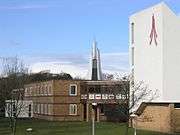Lancaster University
 | |||||||||||||||||||||||
| Motto | Latin: Patet omnibus veritas | ||||||||||||||||||||||
|---|---|---|---|---|---|---|---|---|---|---|---|---|---|---|---|---|---|---|---|---|---|---|---|
Motto in English | "Truth lies open to all" | ||||||||||||||||||||||
| Type | Public | ||||||||||||||||||||||
| Established | 1964 | ||||||||||||||||||||||
| Endowment | £5.9 million (as of 31 July 2017)[1] | ||||||||||||||||||||||
| Budget | £267.0 million (2016-17)[1] | ||||||||||||||||||||||
| Chancellor | Alan Milburn | ||||||||||||||||||||||
| Vice-Chancellor | Mark Smith[2] | ||||||||||||||||||||||
Academic staff | 1,490[3] | ||||||||||||||||||||||
Administrative staff | 3,025 | ||||||||||||||||||||||
| Students | 13,615 (2016/17)[4] | ||||||||||||||||||||||
| Undergraduates | 9,690 (2016/17)[4] | ||||||||||||||||||||||
| Postgraduates | 3,925 (2016/17)[4] | ||||||||||||||||||||||
| Location |
Bailrigg, City of Lancaster, England 54°00′37″N 2°47′08″W / 54.01028°N 2.78556°WCoordinates: 54°00′37″N 2°47′08″W / 54.01028°N 2.78556°W | ||||||||||||||||||||||
| Campus | Bailrigg | ||||||||||||||||||||||
| Colours |
"Quaker Grey" and red | ||||||||||||||||||||||
| Affiliations | N8 Group, ACU, AACSB, AMBA, NWUA, EQUIS, Universities UK | ||||||||||||||||||||||
| Website | www.lancaster.ac.uk | ||||||||||||||||||||||
 | |||||||||||||||||||||||
Lancaster University (officially the University of Lancaster)[5] is a public research university in the City of Lancaster, Lancashire, England. The university was established by Royal Charter in 1964,[6] one of several new universities created in the 1960s.
The university was initially based in St Leonard's Gate in the city centre, before moving in 1968 to a purpose-built 300 acres (120 ha) campus at Bailrigg, 4 km (2.5 mi) to the south.[6] The campus buildings are arranged around a central walkway known as the Spine, which is connected to a central plaza, named Alexandra Square in honour of its first chancellor, Princess Alexandra.
Lancaster is one of only six collegiate universities in the UK; the colleges are weakly autonomous. The eight undergraduate colleges are named after places in the historic county of Lancashire, and have their own campus residence blocks, common rooms, administration staff and bar.
It is currently one of only nine universities to be ranked in the top 10 across all national league tables of UK universities.[7] Lancaster was also awarded University of the Year by The Times and Sunday Times Good University Guide (2018) and it holds its highest ever institutional ranking of 6th place within the guide's national table.[8] The annual income of the institution for 2016–17 was £267.0 million of which £37.7 million was from research grants and contracts, with an expenditure of £268.7 million.[1]
Along with the universities of Durham, Leeds, Liverpool, Manchester, Newcastle, Sheffield and York, Lancaster is a member of the N8 Group of research universities. Elizabeth II, Duke of Lancaster, is the visitor of the University. The current chancellor is Alan Milburn, since 2015.[9]
History
After the Second World War higher education became an important concern of government as it tried to cope with the demands of an expanding population and the advent of a new technological age. Between 1958 and 1961 seven new plate glass universities were announced including Lancaster. The choice of Lancaster as the site of the fourth new university was announced on 23 November 1961 in a written answer in the House of Commons.[10]
.jpg)
The university was established by royal charter in 1964. The charter stipulated that Princess Alexandra of Kent be the first chancellor. She was inaugurated in 1964.[11] The ceremony also saw the granting of various honorary degrees to dignitaries including the Prime Minister, Harold Wilson. Princess Alexandra retired as chancellor in 2004 and was the longest serving chancellor of any British university. On her departure, she gave approval for the Chancellor's Medal to be awarded for academic merit to the highest-performing undergraduates and postgraduates. Each year presentations are made to up to five graduates of taught masters' courses and up to six to the highest-performing undergraduates.
The university accepted its first students in October 1964 and there were initially 13 professors, 32 additional members of teaching and research staff, 8 library staff and 14 administrators on academic grades. The motto, "patet omnibus veritas", ("Truth lies open to all"), was adopted. The first science students were admitted in 1965.
The university was temporarily based in the city. A lecture theatre and the university's first Junior Common Room were based in Centenary Church, a former Congregational church beside the old factory premises of Waring & Gillow, which were used to accommodate the new students. Many new students were housed in Morecambe. The Grand Theatre was leased as a main lecture room and 112 and 114 in the St Leonard's Gate area became teaching and recreational rooms. The library occupied the old workshops of Shrigley and Hunt on Castle Hill.
Bowland and Lonsdale were founded as the University's first two colleges, and all staff and students were allocated to one of the two, although the first college buildings would not be completed until 1966. The first students moved into residence and set up the first JCRs in October 1968.[12]
The University moved from the city to the new campus at Bailrigg between 1966 and 1970.[13]
In 2014, Lancaster University celebrated its 50th anniversary with a series of events throughout the year, involving alumni, staff, students and local community members.[14]
Campus
Bailrigg
The purpose-built campus occupies Bailrigg, a 360-acre (0.563 sq mi; 1.457 km2) site[15] donated by Lancaster City Council in 1963.[16] The campus buildings are located on a hilltop, the lower slopes of which are landscaped parkland which includes "Lake Carter" duck pond and the university playing fields. Lake Carter is named after Charles Carter, the first Vice Chancellor of the university, and it was built in the early 1900s.[6] The site is three miles (5 km) south of the city centre. Construction of the Bailrigg campus began in November 1965, with the first building completed a year later. The first on-campus student residences opened in 1968.[16]
In contrast to some of the other campus universities, Bailrigg was designed to integrate social, residential and teaching areas. Another major feature of the design was that there would not be a large central Students' Union building, but that the individual colleges would be the centre of social and recreational facilities.[17] Vehicular and pedestrian traffic is separated: this is achieved by restricting motor vehicles to a peripheral road with a linking underpass running east-west beneath Alexandra Square. The underpass accommodates the Bailrigg bus station and was refurbished in autumn 2010. Car parking is arranged in cul-de-sacs running off the peripheral road.
The campus buildings are arranged around a central walkway known as "The Spine".[18] The walkway runs from north (County College) to south-west (Graduate College) and is covered for most of its length. The main architect was Gabriel Epstein of Shepheard and Epstein.[16] On a barren hilltop on a windswept day in 1963 the two architectural partners surveyed the future site of the university, Peter Shepheard recalled that day:
"We went up there on a windy day, and it was freezing cold. Every time we opened a plan it blew away. And we said Christ! What are we going to do with these students, where are they going to sit in the sun and all that? Well, we decided, it's got to be cloisters. All of the buildings have got to touch at the ground. We then devised this system and it had an absolutely firm principle: it had a great spine down the middle where everybody walked. That led everywhere. The cars were on the outside, on both sides. When you came into the spaces things were square, they were rectangular courtyards and they were all slightly different. There were two or three essentials: one was that the covered way had to be continuous, the buildings had to be three or four storeys high and connecting to the next one. I thought it worked very well."[19]
Since 2016 the Spine has been extensively remodelled in a project known as "Design The Spine", with the aim of replacing the decaying wooden canopy, widening bottlenecks, and creating new landscaped green spaces.[20][21] Construction began in 2016 and was due to be finalised by the end of Spring 2018, but remains ongoing. The project has been criticised for its confusing diversions, causing unnecessary disruption and congestion, and damage to campus businesses.[22][23]
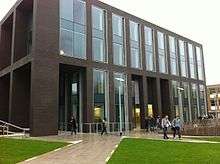
Alexandra Square is the University's main plaza. Named after the first chancellor, HRH Princess Alexandra, it is situated at the centre of the original campus and contains the library in the south-west corner, designed in 1964 by Tom Mellor and Partners, the first phase opening in September 1966, the second in July 1968 and the third in January 1971.[24] The library was extended in 1997 and underwent a phased refurbishment in 2014, which was completed in 2016. In 1998 the Ruskin Library designed by Sir Richard MacCormac was opened. On the west side of the square is University House as well as various banks and shops. To the south-east of the square is the tallest building on campus: the fourteen-storey Bowland Tower, which contains accommodation and disguises the boiler room chimney.
One of the most distinctive of the Bailrigg buildings is the free-standing University Chaplaincy Centre. Opened on 2 May 1969, the architects were the Preston-based firm Cassidy & Ashton. The building has a trefoil plan with a central spire where the three circles meet. The university's former logo is based on the spire.
A plan existed to have a twin campus with another eight colleges to the east of the M6 motorway at Hazelrigg. This would have been linked to Bailrigg by a flyover. The plan was abandoned in the 1970s during a period of financial difficulties.
South-west campus

The university began expansion onto the lower slopes of Bailrigg with the development of new buildings for Graduate College in 1998, which is now part of South-West Campus. Development continued with the construction of InfoLab 21 and Alexandra Park which now houses Lonsdale College, Cartmel College and the en-suite rooms of Pendle College. The development of InfoLab 21 met objections with the proposed building being described as a "Dalek factory".[25]
Cartmel College is built around Barker House Farm, a listed 17th-century farmhouse and outbuildings that form the centre of the college.[26]
Health innovation centre
The university is planning a "Health Innovation Campus" adjacent to the existing campus. The campus will create 2,000 jobs and boost the local economy by around £100 million.[27] The £29.7 million contract for construction of the first building was awarded to BAM Construction in October 2017, with construction beginning in December 2017 and completion by September 2019. This building will be 80,000 square feet and will require the construction of an access road with a junction to the A6.[28][29][30][31]
Services
The Bailrigg campus hosts a range of shops and services. Services on campus include Bailrigg post office, Barclays Bank, Santander Bank, a health centre, a pharmacy and a dental practice. Shops on campus include a SPAR supermarket, LUSU Central (a convenience store), a Subway, a charity shop (the proceeds of which go to St. Johns Hospice), a WHSmith, a hairdressers, Greggs, Costa, Blackwells, Go Burrito, Wok In, Juicafe, Sultan of Lancaster, Wongs and an ice cream parlour open in the summer months.
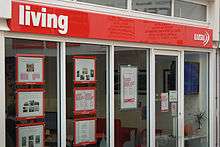
Cultural venues
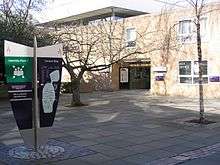
At the north end of campus, the University’s Great Hall Complex comprises three venues open to both students and the public; the Peter Scott Gallery, the Nuffield Theatre and the Lancaster International Concert Series. In 2009, these three organisations were combined as one department by the University – initially termed ‘The Public Arts’ but later renamed ‘Live at LICA’ – with Matt Fenton overseeing this unification.[32] In August 2015 Live at LICA was rebranded to 'Lancaster Arts at Lancaster University' to avoid confusion with the department of LICA, then director Jamie Eastman stated that; "This new name and logo communicates who we are, where we are and what we’re offering."[33]

The Peter Scott Gallery is open to the public free of charge. The Gallery is located on the Bailrigg campus and houses the University's international art collection, which includes Japanese and Chinese art, antiquities, works by twentieth-century British artists including works by artists from the St Ives School, Sir Terry Frost, Wilhelmina Barns-Graham, Barbara Hepworth and William Scott. Among other British artists whose work is represented are Norman Adams, Patrick Caulfield, Elizabeth Frink, Kenneth Martin and Winifred Nicholson. Within the last fifteen years works by Andy Goldsworthy, Peter Howson and Albert Irvin have been acquired. The university collection also includes prints by significant European artists such as Dürer, Miró, Ernst and Vasarely.
Lancaster International Concert Series is the main provider of classical music in north Lancashire and Cumbria. Concerts are held within the Great Hall. Between October and March each year the series offers a varied diet of music which includes: orchestral concerts, chamber music, events for young people, jazz, family concerts and world music. Under the leadership of Professor Tony McEnery, Dean of the Faculty of Arts and Social Sciences, music as a subject for study at Lancaster was abandoned in 2009.
The Nuffield Theatre, a black-box theatre, is one of the largest and most adaptable professional studio theatres in Europe. It presents public performances in the fields of theatre, contemporary dance and live art from some of the best-known and respected companies from the UK and abroad. The focus of the work is new and experimental practice, a focus it shares with many of the teaching and research interest of Lancaster Institute for the Contemporary Arts (LICA). The Nuffield presents up to 30 visiting professional shows a year, plus public performances by students from Theatre Studies, and the University’s student theatre and dance societies and a range of local community organisations.
The Ruskin Library houses archive material related to the poet, author and artist John Ruskin. It is open to the public, although only a small part of the collection is on public display at once. The building was constructed in 1997 by architect Richard MacCormac. The Whitehouse Collection housed in the Ruskin Library is the largest holding of books, manuscripts, photographs, drawings and watercolours by and related to John Ruskin in the world.
Off-campus
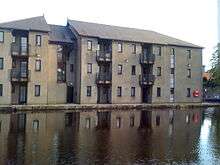
The University maintains two rooms at The Storey in Lancaster city centre as postgraduate study space.[34]
In 2016 the University purchased the 165-acre Forrest Hills conference centre and golf course, located on the M6 opposite the main campus, which it continues to operate as a conference venue.[35][36]
Chancellor's Wharf
Chancellor's Wharf is the name of Lancaster University's off-campus student accommodation.[37] It consists of three buildings by the Lancaster canal on Aldcliffe Road. The location near the city centre, opposite "the Water Witch" pub[38] and the Lancaster Royal Infirmary. It is open to members of all of the University's colleges. Residents remain members of their various colleges, with Chancellor's Wharf itself being only a hall of residence.[37]
Organisation and administration
Colleges
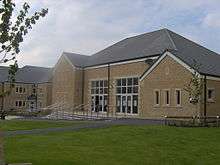
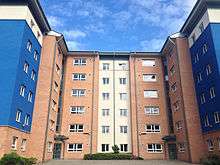
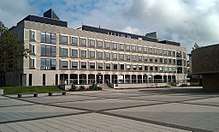
.jpg)
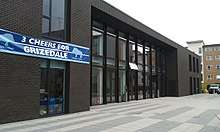

The university has nine colleges. Formerly, these were quasi-autonomous bodies providing for accommodation, welfare, social-life and student discipline, but are currently centrally controlled. All members of the university are members of a college,[40] although in recent years academic staff have had decreasing involvement. Most colleges have about eight or nine hundred members and all on-campus accommodation is linked to a college, with blocks or individual flats being linked to one college or another each year according to demand.[40] The colleges were governed by a syndicate, including a principal (originally a senior academic but nowadays more usually a middle-ranking administrator or IT professional), a Dean and assistant deans (responsible for student discipline), together with a senior advisor, heading a team of College Advisors. These were previously known as Senior Tutor and College Tutors, but the titles were changed in 2011 to Advisor to avoid possible confusion with "Academic Advisors" in students' academic departments. Collectively, the colleges are run by their individual SCR (Senior Common Room) and JCR (Junior Common Room), the latter being made up of student members of the college.
The university has eight undergraduate colleges,[40] seven of which are named after regions of the traditional county of Lancashire, and County College is named after Lancashire County Council, which financed its construction. There is a ninth college for graduates.
| Name | Foundation | Colours[41] | Students (2015/16)[42] | Named after |
|---|---|---|---|---|
| Bowland College | 1964 | 1,230 | Forest of Bowland | |
| Cartmel College | 1968 | 1,080 | Cartmel peninsula | |
| The County College | 1967 | 1,530 | Lancashire County Council | |
| Furness College | 1966 | 1,010 | Furness peninsula | |
| Fylde College | 1968 | 1,040 | The Fylde peninsula | |
| Graduate College | 1992 | 3,610 | Status as a postgraduate college | |
| Grizedale College | 1975 | 1,160 | Grizedale Forest | |
| Lonsdale College | 1964 | 1,420 | Lonsdale Hundred (River Lune and its valley) | |
| Pendle College | 1974 | 1,160 | Pendle region |
The college buildings accommodate a number of academic departments, but are primarily social and accommodation facilities, each with its own bar, which forms part of the university's Commercial Services and is open when profitable.
Academic departments
The University is divided into four faculties.[43] Each faculty is led by a Dean, and each academic department by a Head of Department.[44]
- Faculty of Arts and Social Sciences
- Department of Educational Research
- Department of English Literature and Creative Writing
- Department of History
- Lancaster Institute for the Contemporary Arts (LICA)
- (Art, Design, Film, Theatre)
- Department of Languages and Cultures (DeLC)
- (Chinese, French, German, Italian, Spanish)
- Lancaster University Law School
- Department of Linguistics and English Language
- Department of Politics, Philosophy and Religion
- Department of Sociology
- Faculty of Health and Medicine
- Division of Biomedical and Life Sciences
- Division of Health Research
- Lancaster Medical School
- Faculty of Science and Technology
- Department of Chemistry
- School of Computing and Communications (SCC)
- Department of Engineering
- Lancaster Environment Centre
- (Biological Sciences, Environmental Science, Geography)
- Department of Mathematics and Statistics
- Natural Sciences
- Department of Physics
- Department of Psychology
- Lancaster University Management School
- Accounting and Finance
- Centre for Education, Training and Development (CETAD)
- Department of Economics
- Department of Entrepreneurship, Strategy and Innovation
- Department of Leadership and Management
- Department of Management Science
- Department of Marketing
- Department of Organisation, Work and Technology
The various administrative and technical departments that exist outside of the four faculties are collectively known as Professional Services, and include Facilities, Admissions, and the Library.[45]
Governance
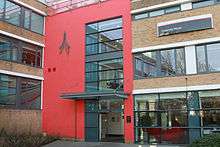
The University is governed by three main statutory bodies: the Council, the Senate, and the Court.
- The Council of the University, chaired by the Pro-Chancellor, is the governing body, consisting of mainly lay members along with representatives of staff and students. It is responsible for the proper management and financial solvency of the university, with major policy decisions and corporate strategy being subject to its approval. The majority of Council members are "lay members"; neither staff nor students of the University.[46]
- The Senate of the University, chaired by the Vice-Chancellor, is the principal academic authority. It oversees academic management and sets strategy and priorities, including the curriculum and maintenance of standards. Membership of the Senate consists mainly of the Faculty deans, heads of academic departments, and college principals.[46]
- The Court offers a means whereby the wider interests served by the University can be associated with the institution, and provides a public forum where members of Court can raise any matters about the University. A majority of the members of the Court are from outside the University, representing the local community and other designated bodies with an interest in the work of the University.[46] The final meeting of the Court took place in January 2018, with the University currently planning to replace it with an "Annual Public Meeting".[47][48]
Visitor
The Visitor of the University is Queen Elizabeth II. The visitor is the final arbiter of any dispute within the university, except in those areas where legislation has removed this to the law courts or other ombudsmen. Student complaints and appeals were heard by the visitor until the Higher Education Act 2004 came into force.[49] All student complaints are now heard by the Office of the Independent Adjudicator for Higher Education.
Chancellor
The Chancellor, currently Alan Milburn, is the formal and ceremonial head of the University.[50]
Former Chancellor Sir Chris Bonington serves as the Chancellor's Ambassador,[51] whilst Roger Liddle is the current Pro-Chancellor and chair of the University Council.
| Name | Duration |
|---|---|
| Princess Alexandra, The Hon Lady Ogilvy LG GCVO | 1964–2004 |
| Sir Christian Bonington CBE | 2005-2014 |
| Alan Milburn[52] | 2015–present |
Vice-Chancellor
The Vice-Chancellor is the chief academic and executive officer of the University. The Vice-Chancellor is supported by the Deputy Vice-Chancellor, three Pro Vice-Chancellors, and the Provost for Student Experience, Colleges and the Library.[53]
| Name | Duration |
|---|---|
| Sir Charles Carter | 1964-1980 |
| Philip Reynolds CBE | 1980-1985 |
| Harry Hanham | 1985-1995 |
| William Ritchie OBE | 1995-2002 |
| Paul Wellings CBE | 2002-2011 |
| Prof Mark Smith | 2011–present |
Academic profile
Admissions
| 2017 | 2016 | 2015 | 2014 | 2013 | |
|---|---|---|---|---|---|
| Applications[54] | 18,720 | 18,170 | 19,420 | 16,850 | 17,120 |
| Offer Rate (%)[55] | 91.3 | 91.2 | 85.8 | 89.1 | 91.0 |
| Enrols[56] | 3,460 | 3,230 | 3,110 | 2,910 | 3,060 |
| Yield (%) | 20.2 | 19.5 | 18.7 | 19.4 | 19.6 |
| Applicant/Enrolled Ratio | 5.41 | 5.63 | 6.24 | 5.79 | 5.94 |
| Average Entry Tariff[57][lower-alpha 1] | n/a | 157 | 402 | 423 | 434 |
In terms of average UCAS points of entrants, Lancaster ranked joint 25th in Britain in 2014.[58] The average entry standard at Lancaster is around 159 UCAS points (new tariff system), with almost all courses requiring at least AAA or AAB at A-level as of 2017. The university gives offers of admission to over 90% of its applicants, the third highest in the UK.[59]
According to the 2017 Times and Sunday Times Good University Guide, approximately 10% of Lancaster's undergraduates come from independent schools.[60] In the 2016-17 academic year, the university had a domicile breakdown of 66:10:23 of UK:EU:non-EU students respectively with a female to male ratio of 51:49.[61]
Reputation and rankings
Global rankings | ||
| ARWU[62] (2018) | 301-400 | |
|---|---|---|
| CWTS Leiden[63] (2018) | 140 | |
| QS[64] (2019) | 131 | |
| THE[65] (2019) | 146= | |
| Complete[57] (2019) |
8 | |
| The Guardian[66] (2019) |
9 | |
| Times / Sunday Times[67] (2019) |
6 | |
British Government assessment | ||
| Teaching Excellence Framework[68] | Gold | |
In The Sunday Times 10-year (1998–2007) average ranking of British universities based on consistent league table performance, Lancaster was ranked joint 19th overall in the UK.[69] As of recent years, the university has been placed within the top 10 by UK newspaper league tables and in the top 150 worldwide by the main global rankings (see information box for current rankings). It was also ranked the top university in the north-west of England for all ten years of recordings by The Complete University Guide.[70]
In 2014, its 50th year, Lancaster University was ranked 10th in the THE 100 Under 50, a list of the world's best universities under 50 years old.[71] It also appeared in the lists of QS 50 under 50 in all the years before 2014 when it was under 50 years old.[72] In July 2017, four of the universities halls of residence (County, Flyde, Grizedale & Furness College) were voted by students in the Top 50 Halls in the UK[73]
Joint programmes
Lancaster University partnered with Sunway University, Malaysia to offer dual awards undergraduate program since 2006.[74]
Lancaster University entered into a dual degree program with the COMSATS Institute of Information Technology (CIIT), Lahore. It simultaneously offered two degrees, from CIIT and Lancaster University; graduates would be alumni of both universities. This was the first programme between a UK and a Pakistani university.[75] However, the dual nature of the programme proved problematic[76] and the relationship ended.
A partnership in a new university venture, University Academy 92 was announced in 2017.[77][78] Lancaster will provide teaching and validate proposed degrees in media, sport, business and psychology at a new campus in Trafford, Greater Manchester.[79] The project was set up by the 'class of 92' Manchester United soccer players Phil Neville, Nicky Butt, Ryan Giggs, Gary Neville and Paul Scholes. Subtext, Lancaster's in house critical newsletter, asked: "Why are we taking a 40% financial stake and a 100% reputational share of what is essentially a new university set up with a group of retired footballers?"[80] Local opinion on the project is also divided as it reaches the planning application stage.[81][82]
Programmes abroad
In October 2013, Lancaster University announced the opening of a branch campus in Accra, Ghana, to serve the population of Ghana and all of Africa, providing a British university-level education locally to those students.[83] The campus is operated in partnership with Transnational Academic Group Ghana Limited, and offers undergraduate and graduate programmes in management, business, Economics & international relations, Politics & International Relations, Accounting & Finance, Marketing, computer science, law and psychology along with an EMBA programme.[83]
Lancaster opened the Joint Institute for Environmental Research and Education (JIE) in Guangzhou, China in 2016, in partnership with the South China Agricultural University (SCAU).[84] A joint Environmental Science undergraduate degree begins in September 2016 with students spending two years at each institution.
The Chinese Ministry of Education gave permission in April 2016 for Lancaster to establish Lancaster University College - Beijing Jiaotong University in Weihai, Shandong province.[85][86]
Research
Lancaster's research income for 2015-16 was £38.3 million. In the 2014 Research Excellence Framework assessment, Lancaster was ranked 18th out of 128 UK universities, including 13th for the percentage of world-leading research. The University places a particular focus on interdisciplinary research, encouraging collaborative research across academic departments.[87][88]
In 2012, Lancaster University announced a partnership with the UK's biggest arms company, (BAE Systems), and four other North-Western universities (Liverpool, Salford, UCLAN and Manchester) in order to work on the Gamma Programme which aims to develop "autonomous systems". According to the University of Liverpool when referring to the programme, "autonomous systems are technology based solutions that replace humans in tasks that are mundane, dangerous and dirty, or detailed and precise, across sectors, including aerospace, nuclear, automotive and petrochemicals".[89]
International Foundation Year
The International Foundation Year is a programme of academic subjects, study skills and English language preparation which is specifically designed to provide international students with a pathway to degree study at Lancaster University.
Students select one pathway from one of six: Business and Management, Engineering and Computing, Law, Life Sciences, Mathematics and Statistics or Social Studies. Once the student completes the programme and achieve the required grades (usually 70% overall), then the student can enter the first year of their chosen undergraduate degree at Lancaster University.[90]
Student life
Students' Union

Lancaster University Students' Union ("LUSU") is the representative body of students at the university. Unusually, there is no main union building – instead the union is organised through the eight college JCRs, each of which has its own social venues and meeting spaces. The union is, however, allocated an administration building by the university. SCAN (acronym for Student Comments And News) is the union's newspaper and was established in 1967, making it the oldest student media on campus. LUSU owns a nightclub in Lancaster called The Sugarhouse;[91] operates a shop on campus, LUSU Central;[92] and also an off campus housing agency LUSU Living.
LUSU also helps to support LUSU Involve, a volunteering unit allowing Lancaster University students to become involved with communities locally and internationally.
There are over 200 different societies operating within Lancaster University. Common areas include sports, hobbies, politics, academic, culture and religion. There are several fairs during the Freshers period in which various clubs and societies promote themselves.
Sport
Every summer term the students take part in the Roses Tournament against the University of York. The venue of the event alternates annually between Lancaster and York. The competition takes its name from the 15th-century civil war, the War of the Roses, and is organised by the universities' respective student unions, LUSU and YUSU.
Lancaster University Athletics Club (LUAC) was formed in May 2011. The start of the 2011/12 academic year saw the first athletes join the club and by the end of the year receive awards for LUSU 'Society of the Year 2012' and were winners of the Lancaster Athletics Cup 2012. In the 2012/13 academic year the club was given the opportunity to compete in BUCS and Roses along with other sporting societies at Lancaster University.[93]
Lancaster University Swimming and Water Polo Club (LUSWP, formally known as LUST) competes in both BUCS and Roses in the sports, swimming and water polo. The swimming team also competes in other charity galas, such as Quest for The Crest, held at Manchester Aquatics Centre. The BUCS swimming competitions include BUCS Short Course National Championships, BUCS Team Championships, and BUCS Long Course Championships, of which there has recently been attendance from Olympic swimmers such as James Guy and 50m & 100m World Champion Adam Peaty. In addition, the water polo team competes in the UPOLO league. LUSWP won the Lancaster University 'Club of the Year' in both academic years 2015/2016, and 2016/2017.
Intercollegiate sport
A number of intercollegiate sporting events exist within the university. Leagues exist in football, netball, pool, darts and dominoes. Pool, darts and dominoes collectively form an overall "bar sports" league known as the George Wyatt Cup.[94][95] The Carter Shield is contested between every college with bi-weekly matches open to all, and is intended as a light-hearted competition to promote lesser known sports.[96][97]
There are also a number of annual sporting events between specific colleges:
- Founders is contested every year between Bowland and Lonsdale, the two oldest colleges at the university. The competition was created in 2004 to ensure that the friendly rivalry between the two colleges would continue after Lonsdale's relocation meant they would no longer be neighbours.[98] The 2018 Founders series was officially cancelled after disagreements between the two colleges, but continued unofficially under the tongue-in-cheek name "Undergrounders".[99]
- Legends was formerly contested between Grizedale, County, Pendle and Fylde colleges. Following Fylde and subsequently County's withdrawal in 2017, it was replaced by the Fylde County Cup and Warriors (Grizedale/Pendle).[100][101]
- Patriots is contested between Furness and Cartmel Colleges.[102]
Arts, Media and Culture
Alongside sport, Lancaster University has a vast selection of arts societies across campus in the areas of performance, media and music. Examples of performance-based societies include Lancaster University Theatre Group (LUTG), the Comedy Institute, Lancaster University Film Production (LUFP), University of Lancaster Music society (ULMS) and Hiphop and Breakdance. There is also the Vagina Monolancs, a student-run group performing the Vagina Monologues, raising awareness of domestic violence against women and girls. In addition, the three most established student media societies consist of the student radio station Bailrigg FM, the student newspaper SCAN established in 1967 and the student union's television station LA1TV. There is also Take 2 Cinema, an on-campus cinema, based in Bowland College Lecture Theatre.[103]
Religious groups
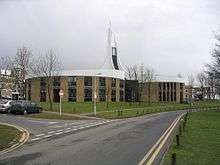
The Lancaster University Chaplaincy Centre is located at the north end of campus incorporating various religious groups such as Christian (Anglicans, Catholics, Orthodox,[104] Quakers), Jewish, Buddhist, Hindu,[105] as well as various religious societies such as the Bahá'í, the Chinese Christian Fellowship, the Postgrad and Mature Students Group and the Pagan society which hold regular events and meetings.[105] The Islamic Prayer Rooms are located across from the Chaplaincy Centre, in Ash House.
Notable people
Alumni
Business
- W. Brian Arthur, Operational Research, 1967 – Economist
- Antony Burgmans, Marketing, 1971, Bowland – Former Chairman of Unilever (until 2007)
- Richard Cuthbertson, Research Director of the Oxford Institute of Retail Management, Oxford University
- Jon Moulton, Chemistry, 1973, Furness – Founder, Better Capital
- Mark Price, Classics & Archaeology, 1982, Bowland – Managing Director of Waitrose
- Bruce Sewell, Psychology, 1979, Bowland – Senior Vice President and General Counsel, Apple
- Dave Snowden, Philosophy, 1975, County College – Knowledge Management researcher and consultant
- Nahed Taher, Economics, 2001, Graduate College – CEO, Gulf One Investment
Media
- Richard Allinson, Economics, 1980, Fylde – Radio presenter
- Louis Barfe, Politics - Journalist
- Robert Fisk, English Literature, 1968, Lonsdale – Middle East correspondent, The Independent
- James May, Music, 1985, Pendle – Television presenter
Arts
- Roger Ashton-Griffiths, Music, 1978, Furness – Actor
- Paula Brackston, MA Creative Writing – Writer
- Lucy Briers, Independent Studies, 1988, Cartmel – Actress
- Brian Clegg, Operational Research, 1977, Bowland – Author of popular science books
- Joseph Delaney, English, 1975, Lonsdale – Writer
- Emily Fleeshman, Theatre Studies, 2007, Manchester – Actress
- Andrew Ford, Music, 1978, Cartmel – Composer
- Rainer Hersch, Economics, 1985, Cartmel – Comedian, musician
- Ursula Holden-Gill, Theatre Studies, 1999, Graduate College – Actress
- Janni Howker, Independent Studies, 1980, MA Creative Writing, 1984, Cartmel – Writer of teenage fiction
- Tez Ilyas, Biochemistry, 2004 – Comedian
- Ralph Ineson, Theatre Studies, 1991, Furness – Actor
- Ursula Martinez, Performance Studies – Performance artist
- Andrew Miller, Creative Writing, 1997 – Novelist
- Caroline Moir English Literature - Author
- Satnam Rana, French Studies, 1999, Grizedale – Television presenter
- Andy Serkis, Independent Studies, 1985, County – Actor
- Ranvir Singh, English and Philosophy, 1998, Pendle – Television presenter
- Dean Sullivan, Teaching Degree - Actor (Played Jimmy Corkhill in Brookside)
- Sarah Waters, English Literature, 1988, Graduate College – Author
- Peter Whalley, Philosophy, 1967, Lonsdale – Writer
Politics and law
- Audrey Azoulay, 1993 – French Minister for Culture and Communication
- Alan Campbell, Politics, 1978, Furness – MP for Tynemouth
- Simon Danczuk, Sociology, 1992, Cartmel – MP for Rochdale
- Hilton Dawson, Social Admin, 1982, Pendle – Former MP for Lancaster
- Suzanne Evans, Religious Studies, 1987, Cartmel – Former Deputy Chairman of the UK Independence Party
- Theresa Griffin, English and Theatre Studies, 1984 and MA Theatre Studies, 1985, Cartmel – Member of the European Parliament for the North West of England
- Rami Hamdallah, Linguistics, 1988, Graduate College – Prime Minister of the Palestinian National Authority
- Ruth Henig, Baroness Henig CBE, - PhD, History, 1978 - Academic and Deputy Speaker in the House of Lords
- Joan Humble, History, 1972, Lonsdale – Former MP for Blackpool North & Fleetwood
- Alan Milburn, History, 1979, Pendle – Former MP for Darlington and current Chancellor
- Colin Pickthall, Creative Writing, 1967, Lonsdale – Former MP for Lancashire West
- Cat Smith, Sociology and Gender Studies, 2006, Cartmel - MP for Lancaster and Fleetwood
- Helen Southworth, English, 1978, Lonsdale – Former MP for Warrington South
Sport
- Jason Queally MBE, Biological Sciences, 1992, PhD Biological Sciences, Bowland – Cyclist
Education
- Alfred Morris, Accounting and Finance, 1970, Graduate College – Former Vice-Chancellor of University of West of England (until 2006)
- Mimi Sheller PG Cert, Learning and Teaching in Higher Education, 2003, - Professor of Sociology, Drexel University)
References
- ↑ New UCAS Tariff system from 2016
- 1 2 3 "Financial Statements for the Year to 31 July 2017" (PDF). Lancaster University. p. 24. Retrieved 11 December 2017.
- ↑ Lancaster University. "Lancaster appoints Professor Mark Smith as new Vice-Chancellor". Retrieved 4 January 2012.
- ↑ Anon. "University of Lancaster Annual Report" (PDF). University of Lancaster. p. 45. Retrieved 3 January 2011.
- 1 2 3 "2016/17 Students by HE provider, level, mode and domicile" (CSV). Higher Education Statistics Agency. Retrieved 25 March 2018.
- ↑ "Charter, Statutes and Ordinances of the University of Lancaster" (Microsoft Word document). Retrieved 28 July 2009.
- 1 2 3 "Origins and Growth - Lancaster University". Retrieved 16 July 2015.
- ↑ "Lancaster University: Our Reputation". Retrieved 10 March 2016.
- ↑ "Lancaster named University of the Year". Lancaster University.
- ↑ Copeland, Alexa (4 March 2015). "Former Darlington MP Alan Milburn appointed as university chancellor". The Northern Echo. Retrieved 9 February 2018.
- ↑ "New University (Lancaster)". Hansard. 23 November 1961. Retrieved 27 February 2017.
- ↑ McClintock, Marion (2011). Shaping the Future a history of The University of Lancaster 1961-2011. Lancaster UK: 1010 Printing International.
- ↑ "History". www.lancaster.ac.uk. Retrieved 31 January 2018.
- ↑ University, Lancaster. "History of Lancaster University | Lancaster University". www.lancaster.ac.uk. Retrieved 31 January 2018.
- ↑ "Help us celebrate the University's 50th Anniversary Year in 2014!". Lancaster University.
- ↑ "Our Campus". Retrieved 14 November 2012.
- 1 2 3 page 115, Building the New Universities, Tony Birks 1972
- ↑ page 120, Building the New Universities, Tony Birks 1972
- ↑ Emma Vickers and Emma Edwards (May 2002). "The Spine". History of Lancaster University. Lancaster University. Archived from the original on 28 December 2007. Retrieved 14 June 2008.
- ↑ page 119, 'Peter Shepeard' edited by Annabel Downs, 2004, Landscape Desin Trust, I.S.B.N. 0-415-35110-3
- ↑ "Spine Remodelling | Facilities | Lancaster University". www.lancaster.ac.uk. Retrieved 25 January 2018.
- ↑ Gillings, Mathew (2016-03-16). "Spine refurbishment design released". SCAN. Retrieved 2018-10-07.
- ↑ Gilmour, James (2017-02-28). "Pizzetta loses 70% of business due to Spine developments, says proprietor". SCAN. Retrieved 2018-10-07.
- ↑ "Will Lancaster University's Spine project ever be finished?". simonbatterbury.wordpress.com. 2018-01-31. Retrieved 2018-10-07.
- ↑ The Library Building: University of Lancaster 1972
- ↑ Booth, Steve (27 September 2002). "Greenfield Development Planned From Lancaster to the University". Virtual Lancaster. Archived from the original on 20 June 2008. Retrieved 14 June 2008.
- ↑ "College Facilities — Cartmel College". cartmel.lusu.co.uk. Archived from the original on 18 September 2016. Retrieved 20 August 2016.
- ↑ "Health Innovation Campus moves a step closer". www.lancaster.ac.uk.
- ↑ "Place North West - Tenders invited for Lancaster science park". 24 March 2017.
- ↑ "Place North West - BAM wins first phase of Lancaster health campus". 30 October 2017.
- ↑ "BAM wins second Lancaster Uni job". www.theconstructionindex.co.uk.
- ↑ "Place North West - Bam starts on first phase of Lancaster health campus". 19 December 2017.
- ↑ , Matt Fenton's profile at LICA
- ↑ , Lancaster University News and Blogs: Smart start for arts and culture on campus. 13 August 2015. Retrieved 21 March 2016.
- ↑ "New city centre study space | Lancaster University". www.lancaster.ac.uk. Retrieved 14 March 2018.
- ↑ "Lancaster University takes over golf and fishing business". Retrieved 14 March 2018.
- ↑ University, Lancaster. "Forrest Hills | Lancaster University Conferences and Events". www.lancaster.ac.uk. Retrieved 14 March 2018.
- 1 2 "Chancellor's Wharf | Accommodation". Lancaster University. Retrieved 9 August 2017.
- ↑ "Returning Students 2017 | Accommodation". Lancaster University. Retrieved 9 August 2017.
- ↑ "A tale of nine colleges". SCAN. Lancaster University Students' Union. Retrieved 8 February 2018.
- 1 2 3 Anon. "University of Lancaster – Colleges". University of Lancaster. Retrieved 27 February 2008.
- ↑ "Branding". Lancaster University Students' Union. Archived from the original on 29 September 2017. Retrieved 28 September 2017.
- ↑ "Nine Colleges Annual Report 2015-16" (PDF). Lancaster University. Lancaster University. Retrieved 8 January 2018.
- ↑ "Faculties and Departments". Lancaster University. Lancaster University. Retrieved 5 January 2018.
- ↑ "Lancaster University Structure September 2017" (PDF). Lancaster University. Lancaster University. Retrieved 5 January 2018.
- ↑ "Professional Services". Lancaster University. Lancaster University. Retrieved 5 January 2018.
- 1 2 3 "University Governance Structure". Lancaster University. 6 December 2017. Retrieved 5 January 2018.
- ↑ "Union President calls for guarantees from university management @ Lancaster Students' Union". lancastersu.co.uk. Retrieved 31 January 2018.
- ↑ "UNIVERSITY COURT NEWSFLASH". subtext. 22 January 2018. Retrieved 31 January 2018.
- ↑ "Legislation.gov.uk".
- ↑ "Governance | Lancaster University". www.lancaster.ac.uk. Retrieved 5 January 2018.
- ↑ "Chancellor's Ambassador | Lancaster University". www.lancaster.ac.uk. Retrieved 5 January 2018.
- ↑ "The Rt Hon Alan Milburn will start as Lancaster University's Chancellor from 1 January 2015". Lancaster University. 30 April 2014. Retrieved 29 January 2015.
- ↑ University, Lancaster. "Senior Officers | Lancaster University". www.lancaster.ac.uk. Retrieved 5 January 2018.
- ↑ "End of Cycle 2017 Data Resources DR4_001_03 Applications by provider". UCAS. UCAS. 2017. Retrieved 25 January 2018.
- ↑ "Sex, area background and ethnic group: L14 Lancaster University". UCAS. UCAS. 2017. Retrieved 25 January 2018.
- ↑ "End of Cycle 2017 Data Resources DR4_001_02 Main scheme acceptances by provider". UCAS. UCAS. 2017. Retrieved 25 January 2018.
- 1 2 "University League Table 2019". The Complete University Guide. Retrieved 26 April 2018.
- ↑ "University League Table 2017". Complete University Guide. Retrieved 15 February 2016.
- ↑ Barradale, Greg. "Which is the hardest university to get into in the UK? Find out here". Retrieved 31 October 2017.
- ↑ "The Times and Sunday Times Good University Guide 2017". The Good University Guide. London. Retrieved 16 August 2016. (subscription required)
- ↑ "Where do HE students study?". hesa.ac.uk. Higher Education Statistics Authority. Retrieved 9 February 2018.
- ↑ "Academic Ranking of World Universities 2018". Shanghai Ranking Consultancy. Retrieved 15 August 2018.
- ↑ "CWTS Leiden Ranking 2018 - PP top 10%". CWTS Leiden Ranking 2018. Retrieved 16 May 2018.
- ↑ "QS World University Rankings 2019". Quacquarelli Symonds Ltd. Retrieved 6 June 2018.
- ↑ "World University Rankings 2019". Times Higher Education. Retrieved 26 September 2018.
- ↑ "University league tables 2019". The Guardian. 29 May 2018. Retrieved 29 May 2018.
- ↑ "The Times and Sunday Times University Good University Guide 2019". Times Newspapers. Retrieved 23 September 2018.
- ↑ "Teaching Excellence Framework outcomes". Higher Education Funding Council for England. Retrieved 11 June 2018.
- ↑ "University ranking based on performance over 10 years" (PDF). The Times. London. 2007. Archived from the original (PDF) on 14 April 2008. Retrieved 28 April 2008.
- ↑ "North West - Top UK University League Tables and Rankings 2017".
- ↑ "150 Under 50 Rankings". 13 April 2015.
- ↑ "The QS top 50 universities under 50 2012". 29 May 2012.
- ↑ "Best Student Accommodation in 2017 - Reviewed by 10,834 students". www.studentcrowd.com.
- ↑ "Lancaster University and Sunway University Partnership".
- ↑ "UK and Pakistan to share degree". BBC News. Retrieved 17 October 2017.
- ↑ "Lancaster – COMSATS Dual-Degree Programme Under Scrutiny". Retrieved 17 October 2017.
- ↑ "New education project launched in Manchester - Lancaster University". www.lancaster.ac.uk.
- ↑ "University Academy 92". www.ua92.ac.uk.
- ↑ https://www.ua92.ac.uk/ua92-and-lancaster-university/
- ↑ "Subtext". www.lancaster.ac.uk.
- ↑ Williams, Jennifer (14 February 2018). "Campaign against Gary Neville plans for sports university on green belt land". Daily Mirror.
- ↑ Gilmour, James (16 February 2018). "Lancaster's UA92 project granted permission to continue after rocky start".
- 1 2 "The first British University branch campus in Ghana will open its doors to students this month" (Press release). Lancaster University. 18 October 2013.
- ↑ "China environment institute launch - Lancaster Environment Centre - Lancaster University".
- ↑ "Lancaster to open new China campus with Beijing Jiaotong University - Lancaster University".
- ↑ "LU College China - Lancaster Environment Centre - Lancaster University".
- ↑ "2014 REF Announcement | Department of Languages & Cultures". www.lancaster.ac.uk. Retrieved 24 June 2018.
- ↑ "Research". www.lancaster.ac.uk. Retrieved 24 June 2018.
- ↑ "PHP - School of Engineering - University of Liverpool". Retrieved 16 July 2015.
- ↑ "International Foundation Year | Lancaster University International Study Centre". www.lancasterisc.com. Retrieved 24 June 2018.
- ↑ "The Sugarhouse nightclub @ Lancaster Students' Union". lancastersu.co.uk. Retrieved 14 March 2018.
- ↑ Orton, Ollie (29 February 2016). "LUSU Shop to close; Central to be refurbished". SCAN. Retrieved 14 March 2018.
- ↑ "Lancaster University Athletics Club". Archived from the original on 24 June 2012.
- ↑ "College sport @ Lancaster Students' Union". lancastersu.co.uk. Retrieved 21 February 2018.
- ↑ "George Wyatt: Four weeks to go". SCAN. 20 February 2011. Retrieved 21 February 2018.
- ↑ Hamlyn, George (29 November 2016). "The Carter Shield Returns". SCAN. Retrieved 21 February 2018.
- ↑ "Sport". Pendle College. 15 January 2016. Retrieved 21 February 2018.
- ↑ "Founders - Lonsdale College | Lancaster University". Lonsdale College | Lancaster University. Retrieved 21 February 2018.
- ↑ Callender, Sarah (24 May 2018). "Unofficial event "Undergrounders" bid to replace Founders". SCAN. Retrieved 24 June 2018.
- ↑ Crow, Bethany (7 March 2017). "County and Fylde abandon Legends". SCAN. Retrieved 21 February 2018.
- ↑ Pearson, Tom (4 October 2017). "Bragging Rights: Why you should join College Sport". SCAN. Retrieved 21 February 2018.
- ↑ Bickley, Chris (23 September 2015). "College Sport at Lancaster". SCAN. Retrieved 21 February 2018.
- ↑ "Groups @ Lancaster Students' Union". lancastersu.co.uk.
- ↑ "The website of the Orthodox community of Lancaster University". Retrieved 6 May 2015.
- 1 2 http://www.lancaster.ac.uk/depts/chap_cen The Lancaster University chaplaincy Center website
Bibliography
External links

